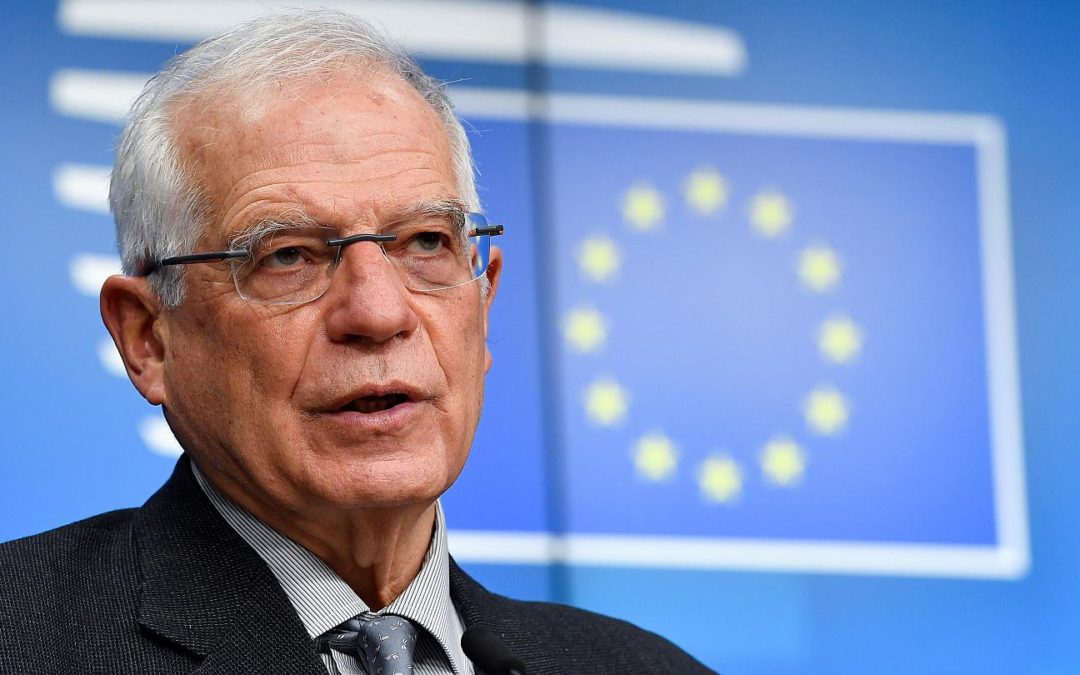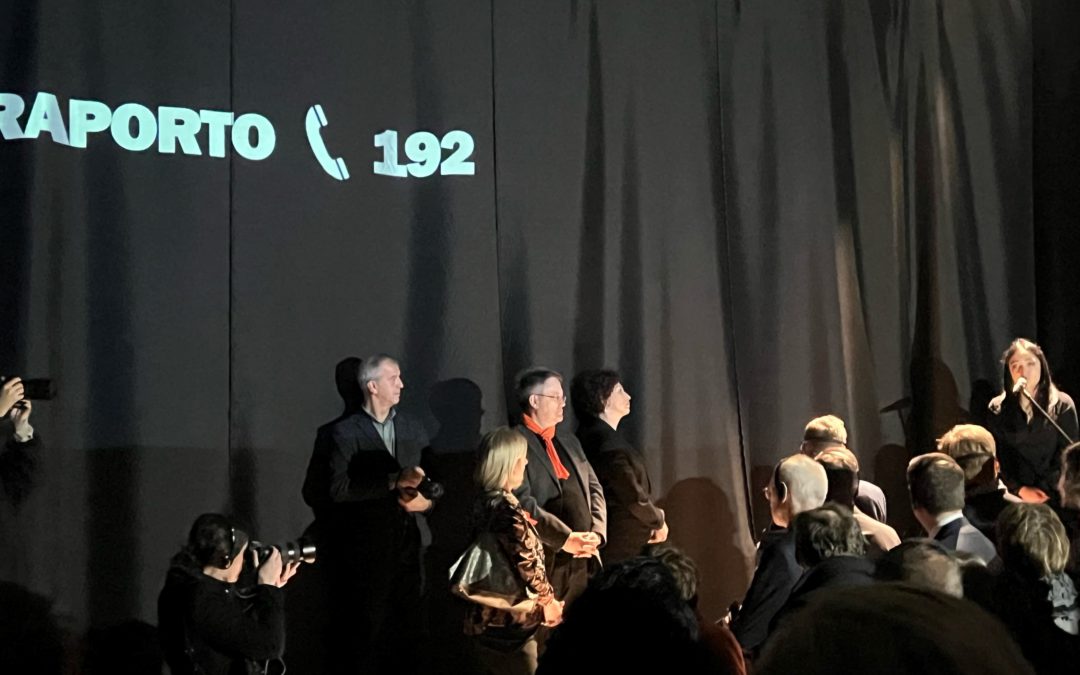Pristina’s urban landscape, though congested with vehicles and buildings, is easy enough for most to navigate.
For its disabled residents, however, getting around Pristina is, at best, a nuisance—and at worst, it’s downright dangerous.
Even something as simple as crossing Agim Ramadani Street becomes a chore for people in wheelchairs. Near Skanderbeg Square, for instance, the curb has no slope leading into the crosswalk. To get across the road there, wheelchair users have to travel a few dozen meters to find an intersection they can roll through without falling into the road.

Even where ramps have been installed, poor maintenance of the sidewalk can make them less accessible, such as this one on Agim Ramadani Street.
Things have improved over the years, however, according to municipal official Linda Spahiu Emërllahu. She works for the Urban Regeneration Office, a branch of government in Pristina which has overseen a number of disability-friendly developments. She flipped through a brochure of glossy photos documenting the work she and her office have accomplished since Pristina’s mayor Shpend Ahmeti began his first term four years ago.
Spahiu Emërllahu rattled off the projects the office is currently overseeing: Making Pristina’s schools more accessible, installing lifts in medical care centers, ensuring that all public buildings have ramps. Her goal, she said, is for the government to outfit all of Pristina’s neighborhoods with greater accessibility. “All the architectural projects procured by the municipality need to be accessible.”
The municipality has made several notable improvements since 2014. Parks have been outfitted with accessible play equipment for children with disabilities, many crosswalk signs now have audible signals for the blind, and government buildings have ramps so that wheelchair users can enter.
Spahiu Emërllahu expressed particular pride with the installation of tactile tracks, textured strips of pavement that allow people with poor eyesight to detect where the sidewalk ends and the road begins.
Rinor Gashi, formerly with the organization HandiKos, has also witnessed a number of positive changes over the years. He has used a wheelchair since a wartime accident in 1999. Since 2000, Gashi said, there are “more public spaces, more roads, that are accessible” for people with disabilities—places like the city center, around Mother Teresa Boulevard, where pathways and businesses have few obstructing features.

Stairs on Garibaldi Street were renovated several years ago, but businesses there remain inaccessible for wheelchair users. Even entrances at ground level lead to more stairs.
But changes don’t always come fast enough. Even along Garibaldi Street, one place that Gashi mentioned was more accessible than much of Pristina, only one business, Central Café, is easily wheelchair-accessible. Between Zahir Pajaziti Square and the first major intersection, more than 40 businesses have stairs leading up to the first floor or down into the ground. There are no ramps in sight.
Despite positive developments in some areas, Pristina is still a difficult city to navigate, according to Gashi.
“Roads are not accessible, buildings are even more inaccessible. There are few public places that you can join freely because they aren’t accessible.” Apart from public buildings, many of which are being renovated, there are still private businesses: “Restaurants, cafés—ninety-nine percent of them are not accessible.”
His perception is justified, although exact data is hard to come by. Along the stretch of Agim Ramadani between Skanderbeg Square and the Ministry of Education, Science, and Technology, an accessibility audit suggests that about 60 businesses at street level cannot be entered by wheelchair users without assistance. Options become limited very quickly: Among the eight accessible businesses, there are two banks, two clothing stores, and a single fast-food restaurant.
Wheelchair users in Pristina occasionally need to get inside inaccessible buildings in order to shop or socialize, and Gashi is no exception. It’s a tedious ordeal:
“Every time, I need help from my friends, my colleagues, or…” He trailed off.
Or he doesn’t get in.
Even where ramps do exist, accessibility does not always follow.
The National Library of Kosovo, for instance, has a ramp that was built to make it accessible, at least in theory. In practice, however, the concrete ramp is narrow, with no hand rails to assist wheelchair users rolling up or down. Its two sharp turns provide very little room for error, and one simple mistake could mean a nasty fall.
To get to the ramp in the first place requires travelling around the entire building, as the paving stones along the more direct path have been torn up, leaving a shallow, muddy ditch.
Bujar Kadriu, the president of the Kosova Disability Forum (KDF), has his own experiences with Pristina’s inaccessibility. He said that for blind Kosovars, few positive developments have been made.
“In general, I can say that nothing has changed, besides the political dialogue and the political statements,” he said. “There has been some progress in the streets and the parking, but in the information space there has not been much progress.”
Lack of Braille signage and other communicative infrastructure for people with visual impairments is the largest problem, according to Kadriu. Without these, it is difficult for blind people to find the correct buildings or streets without assistance.
And while some crosswalks in Pristina have had audio warnings installed to let the blind know when it is safe to cross, many have no signals whatsoever. Fewer still have tactile tracks or exaggerated visual cues to distinguish between pedestrian pavements and the road.
Pristina’s inaccessible intersections are not only inconvenient—they make it dangerous for blind people to travel alone.
Kadriu was blunt about the municipal government’s role in the current situation: “I don’t think the municipality here in Pristina is doing its best to help the disabled community.”

A ramp leading to a business on Luan Haradinaj Street at an angle larger that legal standards in the US or Europe would allow. An extra obstacle is the six centimeter drop between the ramp and the sidewalk.
Rozafa Basha, a professor of architecture at the University of Pristina, agrees. For five years, her work has focused on making urban spaces more accessible. She counters the government’s narrative that the proper changes are being made to buildings and roads.
Basha explained that when a new ramp is installed, it may be poorly built in order to meet a deadline or budget.
“It’s too steep, it lacks railings, material is not good.”
Other problems arise from misuse or neglect. Improperly parked cars block otherwise accessible sidewalks, and public toilets for people with disabilities are sometimes kept locked from the outside, Basha said.
“This is not one case,” she added. “This is a constant occurrence.”
And these are not unsolvable problems, in her opinion. Basha said even the accessibility issues of Pristina’s privately-owned property could be better addressed.
“The current administration has done some interventions in these private businesses to improve some of the entrances.”
For instance, during Mayor Ahmeti’s first term, businesses on Garibaldi Street were refitted with improved stairs. If the municipality had the power to rebuild stairs, why did they not replace them with more accessible options?
Basha said the administration was “more concerned with aesthetics” than with truly making sure disabled people had access. She also noted that many of the city’s projects were not done in less visible parts of Pristina.
Spahiu Emërllahu did say, while the city had considered replacing the stairs with lifts or ramps, that “it costs very much, and maybe it looks ugly.”
Basha’s research has uncovered similar recurring issues in cities across Kosovo since 2013.
Gashi, who now works in digital marketing, summarized the magnitude of the accessibility problem.
“In general it is very difficult to get around Pristina. In general, all of Kosovo, not just this city.”
The struggles of disabled people are finally breaking into public consciousness across much of the world. In Kosovo, even in the absence of official statistics, policymakers acknowledge that disability is not an uncommon experience. (People with disabilities are 12-15% of the population of Kosovo, according to estimates by the Kosova Disability Forum.
Spahiu Emërllahu explained that the conversation around disability is changing in Kosovo.
“Attention has been realized in a positive way” toward disabled people over the past decade. “Caring for disabled people in society is much more important.”
Kadriu, though, is less impressed with increased public awareness in the absence of increased progress.
“In general,” he said, “the government has the ability to do what has to be done. It’s not the fault of the citizens” that so much is inaccessible to people with disabilities.
Many activists say the greater battle is for legal enforcement. As Kadriu put it, “Rule of law comes first of all.”
Basha also views the lack of enforcement as the major impediment to accessibility in Kosovo.
“We don’t have the same culture of rule of law” that other countries have established. “This is really lacking here, and what is also lacking are the implementation mechanisms.”
Illirljana Geci, a representative for KDF, agreed that “one of the most problematic issues is the legal framework and its implementation.” Without a common understanding that accessibility is a civil right, making positive changes to the physical landscape is a difficult sell.
In much of the Western world, people with disabilities have the protections of a firm legal foundation. The Americans with Disabilities Act (1990), the UK’s Disability Discrimination Act (1995), and the European Accessibility Act (2015) were written to ensure minimum standards of accessibility. If their regulations are not met, disabled people can sue for their right to access.
Kosovo’s only official legal framework for accessibility is a 2007 construction guideline that, according to Basha, is supposed to be followed in the construction of all new buildings.
But without enforcement, the guideline is powerless.
“People don’t respect regulations,” said Gashi.
And even these regulations fail to fully address the needs of people with visual impairments.
Being critical and celebrating advances are not contradictions when it comes to accessibility. According to Basha, Pristina is one of few municipalities to have developed an action plan in line with the National Strategy on the Rights of People with Disabilities 2013-2023. Pristina could be more accessible, but it has been making progress in recent years, while other areas in Kosovo are doing much less.
Gashi put it succinctly.
“There are so many changes compared with 2000 until now, in 2018. Some very big changes in accessibility, but still it’s so far from being good for movement of people with disabilities.”
Further increasing physical accessibility would improve life for many people in Pristina.
“People with disabilities are the community most affected by this problem,” said Basha, “but they are not the only ones.”
She listed several groups that would benefit from more accessible infrastructure: parents who use strollers for their children, small children who have difficulty climbing stairs, and everyone who has to walk in the street because the sidewalk is crowded with cars.
Despite the inconveniences, able-bodied people are able to move without the same restrictions that disabled people face. “Every time you go somewhere, you have to think about what place is accessible,” said Gashi. Inaccessibility is about the physical space, but it also creates a social and psychological barrier between disabled citizens and the society they live in.
For Basha, it all comes down to democracy. In her 2018 report on Pristina’s built environment, she wrote.
“The city can contribute to a more equal, inclusive and cohesive society if the places we live, the facilities we use, and neighborhoods are designed to be accessible and inclusive.”
When Basha spoke about her vision for the future of accessibility, her voice grew more intense, and her gestures more pronounced.
“I’m interested in public spaces. I’m more interested in making the city more democratic,” she said, emphasizing the last two words.
Public space, to her, is “not just about access to physical necessities, but to social life, and to culture.” To make Pristina a more just space, she said that everything must be accessible for everyone.
Kadriu wants disabled people to be treated as if they matter on their own terms. For him, accessibility is an important part of a larger social issue.
“There has to be a unified community of people with disabilities in Kosovo and they have to be treated well — not because other people feel bad for them, but because the rights of the disabled community are human rights, as well.”
(Isaiah Raimey is a reporting intern with KosovaLive this summer, in collaboration with Miami University in the United States.








